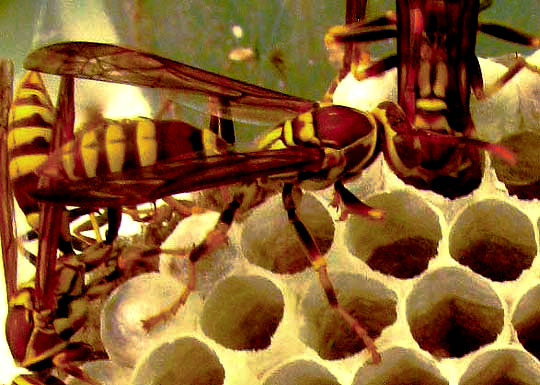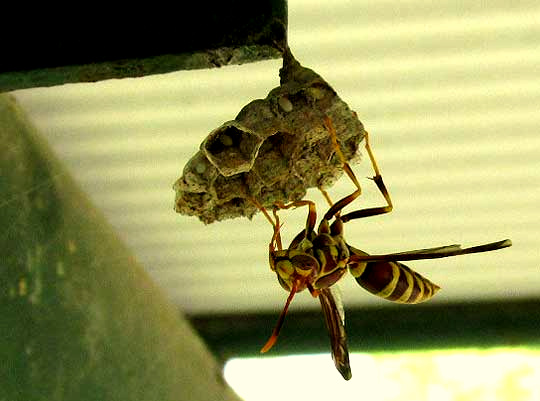Excerpts from Jim Conrad's
Naturalist Newsletter

from the July 20, 2014 Newsletter issued from the Frio Canyon Nature Education Center in the valley of the Dry Frio River in northern Uvalde County, southwestern Texas, on the southern border of the Edwards Plateau; elevation ~1750m (~5750 ft); N29.62°, W99.86°; USA
PAPER WASP
In mid-day heat at Cooks Slough Nature Park on Uvalde's south side I was so sweaty and tired of the sun's glare that when a small shelter beside Lunker Pond came along I lay onto the bench thinking about a little nap. But the instant before I closed my eyes, up in the rafters exactly above me, I saw what's shown above. A close-up of a single wasp is below.

These looked like wasps that back in Mississippi might be inclined to sting if you move around too quickly and too close, and maybe are likely to go for a thick head of hair. I no longer have to worry about wasps getting into my hair, and in fact I was moving slowly that day, so I didn't mind too much having the wasps above me. In fact I was glad to see what seemed to be such a healthy colony forming.
I like paper wasps, which are wasps who build nests of paper, instead of digging burrows in the ground, daubing together nests of mud on walls, or building neat little mud "pots" to be hung in trees. One reason I like paper wasps is that I've seen so many forms of paper nests, especially in the tropics, and I enjoy seeing variations on any natural theme." Also, years ago when I was putting together the wasp page for the BackyardNature.Net website, a real wasp specialist, Dr. Joy Layton, offered to contribute very interesting information she had on the paper wasp life cycle. As is normal, the more you know about something in Nature, the more you appreciate it. You might enjoy Dr. Layton's remarks still online, starting about the middle of the page at http://www.backyardnature.net/wasps.htm.
In the shelter beside Lunker Pond I recognized our species with its ornate, yellow markings on a chestnut body as belonging to the genus Polistes, of which about 300 species are recognized.
Dr. Layton writes of Polistes wasps in general that each spring a single queen wasp, who mated the previous September or October, flies off and with no help from any other wasp starts building her nest, which at first is quite small, consisting of several paper-walled cells in the bottom of which her eggs soon hatch into grubs. Once the grubs need food, she leaves the nest unattended and flies around gathering caterpillars to feed her grub offspring.
Dr. Layton continues: "After about three to four weeks, these grubs pupate and emerge as new workers. They are all female and all sterile. Besides, there are no males alive to mate with anyway, so these workers will not lay eggs but will devote their lives to raising the next set of eggs of the queen."
That's what we're seeing in the first picture -- sterile female workers enlarging and tending the nest, a process that will continue all summer as the nest grows and more sterile female workers appear to increase the colony even larger. In the first picture note that at the bottom of the whiter cells at the lower, right in the picture you can see single eggs. White paper caps have been placed atop some of the egg-containing cells. At the lower left, among the dingier cells, you can see grubs needing to be fed. You can read what happens later in the season on our Wasp Webpage, though I can tell you now that it's a little sad, all the worker sisters dying, with only a few freshly produced males and some females destined to be the next season's queens flying off to mate.
Despite there being so many Polistes species, volunteer identifier Bea in Ontario feels fairly confident -- a distinguishing feature being the orange tips on our wasps' brown antennae -- that our shelter-rafter wasp is POLISTES EXCLAMANS, fairly common in the US southeastern states and northern Mexico, though it's been observed as far north as Missouri, Maryland, and New Jersey, and seems to be expanding its distribution northward, possibly as a result of global warming.
Polistes exclamans produces smaller nests than many other paper wasps, and appears to be especially vulnerable to predation and parasitization, resulting sometimes in the building of "satellite nests" around the main one. Someone has produced an especially detailed Wikipedia page on this species' life history at https://en.wikipedia.org/wiki/Polistes_exclamans
from the August 3, 2014 Newsletter issued from the Frio Canyon Nature Education Center in the valley of the Dry Frio River in northern Uvalde County, southwestern Texas, on the southern border of the Edwards Plateau; elevation ~1750m (~5750 ft); N29.62°, W99.86°; USA
PAPER WASP STARTING OVER
A couple of weeks ago we looked at a colony of paper wasps beneath the roof of a shelter at Cook's Slough Nature Park on the south side of Uvalde. Somebody knocked the nest down, and now where the larger nest had hung there's a much smaller nest with one wasp working on it, presumably the queen. Eggs are visible in the cells. You can see this below

Is this the same queen who lost the previous nest? Whatever the case, I feel sorry about the whole thing.
from the July 30, 2002 Newsletter issued from the woods just south of Natchez, Mississippi, USA
AN INTERESTING WASP NEST
 Tuesday morning I was cutting giant bamboo to build something with when inside the bamboo stem, which was about 3 inches (8 cm) across, I found the nest of a paper wasp. A hole in the stem must have allowed the wasp mother entry. This nest was noteworthy because most of the nest's cells were open. Inside those cells you could see the heads of developing wasp larvae, and in a few cells there were eggs. Here was a beautiful demonstration of wasp metamorphosis. Naturally I scanned the nest and you can see it above, with the larvae heads, eggs and a few capped cells.
Tuesday morning I was cutting giant bamboo to build something with when inside the bamboo stem, which was about 3 inches (8 cm) across, I found the nest of a paper wasp. A hole in the stem must have allowed the wasp mother entry. This nest was noteworthy because most of the nest's cells were open. Inside those cells you could see the heads of developing wasp larvae, and in a few cells there were eggs. Here was a beautiful demonstration of wasp metamorphosis. Naturally I scanned the nest and you can see it above, with the larvae heads, eggs and a few capped cells.
from the May 5, 2002 Newsletter issued from the woods just south of Natchez, Mississippi, USA
AN INTERESTING WASP NEST
On Thursday I noticed that a paper wasp had begun a nest below a bookshelf in my trailer, coming and going through a crack in my ill-fitting screen door. While the mother wasp was out foraging I removed the half-formed nest. She returned and for two days afterwards she sought her nest in the spot it had been. Moreover, earlier, during the time when she had been building her nest, she always entered and exited the crack in my door energetically -- one would say with a sense of purpose. By the end of her second day of seeking the lost nest she would pass through the crack lethargically, hesitatingly. All her purpose seemed gone.
from the June 6, 2004 Newsletter issued from the woods just south of Natchez, Mississippi, USA
WASP CATERPILLAR-BUTCHERING TIME
If you're spending time with your flowers or garden you're likely noticing wasps flying among the plants, sometimes briefly landing and walking around, then flying on. Usually such wasps are looking for prey with which to provision their nests. Paper wasps, yellowjackets and hornets typically collect caterpillars while spider wasps and mud-daubers go for spiders instead.
This week Maureen in Florida wrote telling how she was enjoying the Monarch Butterflies she had attracted into her yard by planting milkweeds. But now wasps were preying on her Monarch caterpillars. She wrote: "Out of dozens and dozens [of caterpillars], only one chrysalis has occurred outdoors. The balance have been devoured, except for the 7 I have brought in to foster."
Maureen sent a picture of a wasp "cleaning up the leftovers from last night's massacre," showing a pretty paper wasp over a black smear. That kind of wasp kills and butchers caterpillars in situ, then carries the pieces back to the nest for feeding the larvae.